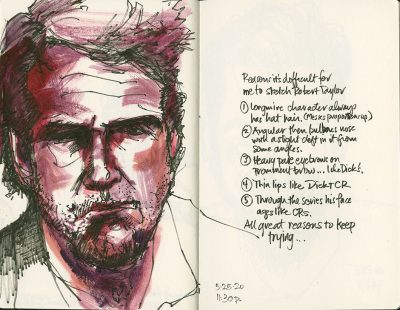 A friend of mine once said he couldn’t understand how I could draw the same subject over and over. I do that a lot. Most notably daily drawings for 4 and a half years of my dog Dottie.
A friend of mine once said he couldn’t understand how I could draw the same subject over and over. I do that a lot. Most notably daily drawings for 4 and a half years of my dog Dottie.
But my life is full of drawing the same subject over and over. Life drawing models I see every other week or more, Dick and his eyebrows, his parents (when they were alive), a succession of peppers (red, green, orange, yellow), eggplants (in various states of decay), skulls, bones, taxidermy, rocks, and of course my Schleich dinosaurs.
Unlike my friend who professed that repeat sketching bored him, I find that sketching a subject a second, third,…tenth,…100th time helps me do a deep dive into the shapes and angles and constructions of the figure of that subject, whether it’s a nose, receding hairline, body proportions—it doesn’t matter, each revisiting helps me understand something not only about the subject but all similar subjects in the world, and ultimately helps me understand what surrounds me in my world.
I can’t encourage you all enough, to sketch the same subject multiple times. Last year in March of 2021 I even encouraged you all to join me in discovering how actor Alun Armstrong is put together—and how we could put him down on paper in a recognizable representation. (See March Is Sketch Alun Armstrong Month in the blog’s search engine.)
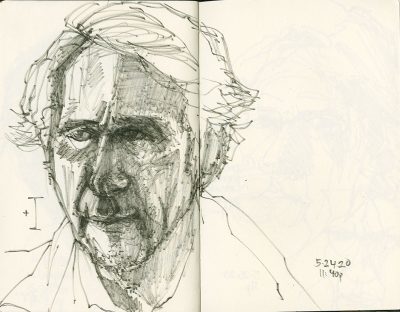 Don’t expect that every challenge you set yourself is going to result in a series of perfect drawings. Let go of that expectation and you’ll be rewarded with lots of lessons along the way. Lessons you’ll be able to call upon when you’re out and about sketching.
Don’t expect that every challenge you set yourself is going to result in a series of perfect drawings. Let go of that expectation and you’ll be rewarded with lots of lessons along the way. Lessons you’ll be able to call upon when you’re out and about sketching.
Today, as the year winds down, I want to remind you to really dig into a single subject yet again.
I’ve dug up some sketches I made while recovering from cataract surgery (dealing with new vision artifacts and visual problems) in 2020. I was watching “Longmire.” An excellent crime drama which is available on Netflix.
My focus for these sketches was mostly the actor Robert Taylor (an Australian actor you may have encountered while watching “Ballykissangle.” (An Irish show.)
I’ve watched “Longmire” 3 times through. (With time in between.) I love it more each time. I keep sketching all the characters and there are lots to choose from if you watch it and want to sketch.
In my first sketch you’ll see a list of what I find difficult about drawing Robert Taylor. (Long-time blog readers will get a laugh from the list.)
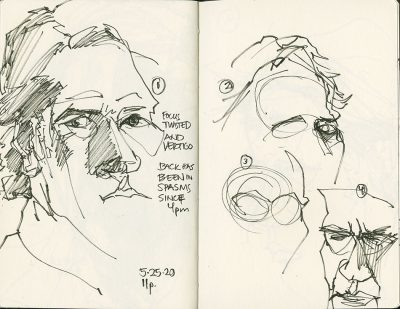 In my next sketch you’ll see how I try to feel around with values to find the shapes in his face. (Something starts to emerge just when it’s time to go to bed it seems!)
In my next sketch you’ll see how I try to feel around with values to find the shapes in his face. (Something starts to emerge just when it’s time to go to bed it seems!)
On other days, I’ll do a series of quick sketches focusing on one feature, like his eyes, seen in the third image in this post.
Doing quick sketches like this of your subject will help you focus in on the features that convey likeness.
Of course when you’re doing portraits the eyes are important. But I’m also quite fond of Longmire’s hat hair.
Profiles are important views that help you understand a face. They help me look at noses as you can see in the fourth page spread of sketches in this post. And I’ll be the first to admit that hats both fascinate and stump me, so I’m constantly looking at hats, especially when the calendar creeps up on the Minnesota State Fair in August—because then I know I’ll be encountering a lot of bill caps.
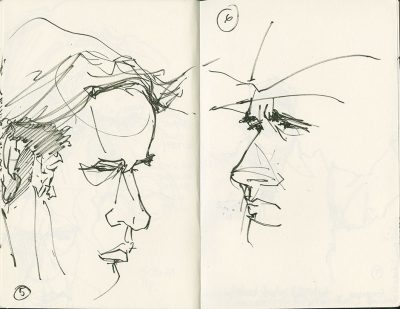 Practice now, with out the dust, crowds, and distraction of corn dogs, is going to make it easier for me to get the angles and proportions of those quickly glimpsed hat-wearing fair-goers later.
Practice now, with out the dust, crowds, and distraction of corn dogs, is going to make it easier for me to get the angles and proportions of those quickly glimpsed hat-wearing fair-goers later.
Tips for Diving into a Series of Sketches
Don’t feel that you have to do a ton of drawings every time you sit down to repeat attempts at understanding a particular subject.
Set a goal to work for an hour and do 5 quick sketches each under 10 minutes, or decide that you’ve already warmed up for the day so you’re going to do 2 longer sketches of 20 to 40 minutes each.
Limit your materials to a single pen or medium that you love working one, and a paper that works well with that medium.
Work on paper that your tool and medium respond well too—but also pick within that range of papers one that is less expensive. In this series I was working on the drawing paper contained in the Hahnemühle Travel Journal. It’s not watercolor paper, but with a little water management I can get it to work for quick sketches. And besides, I really love the light drag that my favorite pens have on this paper.
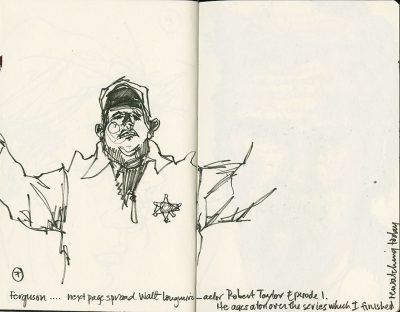 The books are thick with pages and I feel no constraints about pushing through multiple page spreads every session.
The books are thick with pages and I feel no constraints about pushing through multiple page spreads every session.
You could also simply work on loose sheets and keep them in a folder.
It’s nice to have them together so you can review them later as a whole.
Don’t Forget
If you’re working on a series and your subject is not coming to life for you in a way that you had hoped, do try a couple times and from a couple different angles. Learning what you can with each sketch.
But don’t forget that sometimes it is also good to take a visual break and sketch something else. (In the final sketch in this post you’ll see that I drew a sketch of “Fergusson,” who has wonderful ears, and also was wearing a bill cap so that was additional hat practice.)
Taking even a five minute break like this is great. It allows you to refocus, to capture something familiar (like ears!) and build up steam for another attempt at the main subject.
In my State Fair Journals you’ll see me move from cows to people, to sheep to people, to birds to people. The people are just what I sketch while I’m walking to another barn or taking a break to look really hard at the animal subjects (which are my preferred subjects at the Fair).
I find that it’s like sorbet between meal courses—palate cleansing.
Sometimes too you discover the key to what was stumping you visually in the series of sketches.
Whatever it is you want to sketch better, I hope you’ll give sketching in a series a shot. Before the new year, start a new habit that helps you build your drawing practice.



















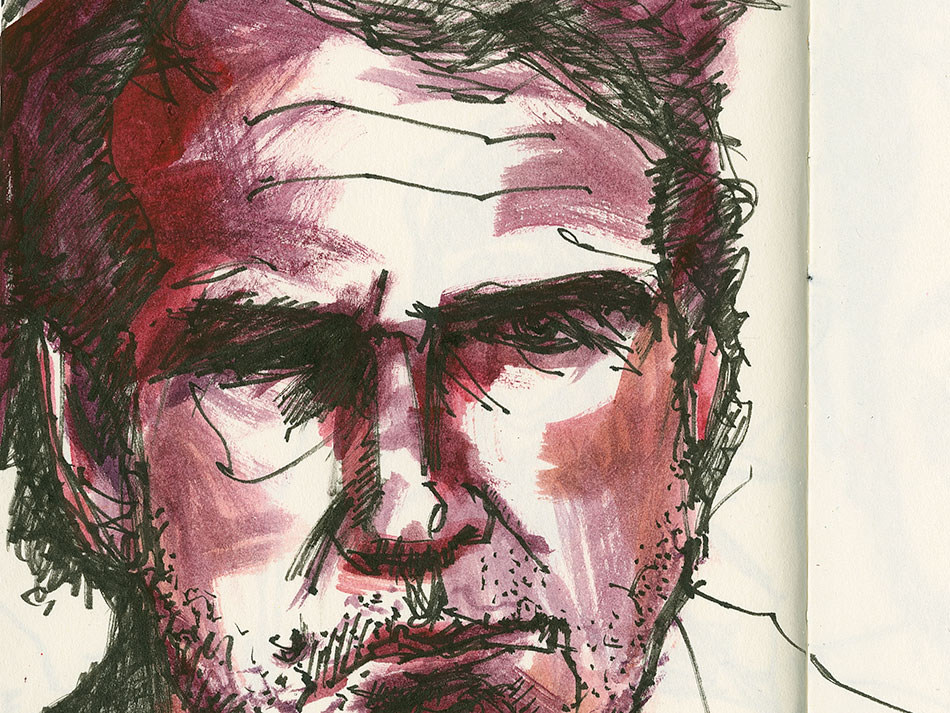
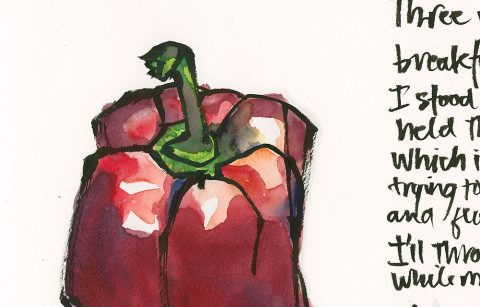
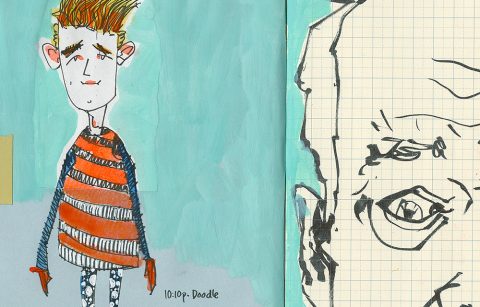
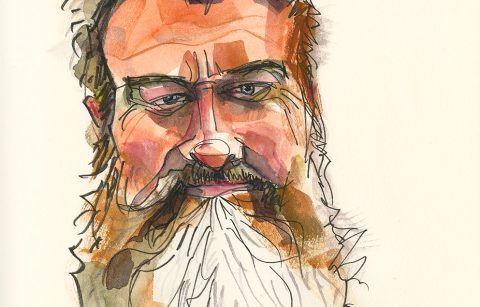
Totally agree about doing a series! Or series of series simultaneously! Years ago I did 100 self-portraits. When the pandemic began, I drew my hand every day until I got vaccinated (407 days). Currently I’m kind of hooked on drawing from Earthsworld’s photos, but not necessarily every day. I’ve also been making small thumbnail composition studies almost every day (mostly from life, sometimes from photos). It helps to have more than one series going at a time to keep it fresh, and sometimes an idea from one will feed the others.
I remember seeing the hand drawings for the pandemic and loved them. That’s just the type of thing I’m thinking about. The more you look at something the more you force yourself to come up with another, and another angle on it, something fresh as you say. So we aren’t always putting down the first idea that comes up.
Do you pause the video to draw from television? Are you drawing without looking down at the paper? I like to draw people and especially their costumes from TV, but find the modern movies so fast paced that I can barely take in what I’m seeing, let alone get anything down on the page. Old movies work better, but I still need to pause to get anything on paper. Just trying to understand how you’re doing it. (Forgive me if this is something you’ve explained before.)
Sharon, I have written quite a lot about my practice of TV sketching over the 14 or more years I’ve been doing the blog, but unfortunately when I went to get links for you much of that is in the now archived material.
So the quick answer is that I draw quick studies with the TV going like this
https://rozwoundup.com/2023/07/in-context-trying-to-catch-up.html
and I’m working very fast and the goal is to work on my visual memory and get as much in as I can, and then put that down on paper.
And then I also sometimes stop the TV and sketch from a still moment. I’m still working quickly. I am to get the sketch done in less than 10 minutes and color it in about 5 minutes, or sometimes sketch in 5 minutes and get the color done in 10, same over all time. And then I do something more like on this page spread https://rozwoundup.com/2023/04/journaling-predictions-and-creative-momentum.html
And when I am stopping the TV in the same viewing session I like to do a series of sketches of the same subject, like this series of Robert Morley portraits https://rozwoundup.com/2021/08/lines-achieving-a-likeness-with-different-approaches.html
Whenever I’m sketching I am more often looking at the SUBJECT and not my paper. I’m also accepting of the errant ink lines and work around them. And I’m always working quickly because it’s a habit but also because for me working quickly keeps me sharp for working from live subjects when I’m out in public sketching.
If you find it impossible to get anything down on the page when the TV image is running you might want to go to something like a bird cam (there are hundreds on the internet) and sit and let the video run and sketch those birds coming and going. They are still flattened by the camera, but there will be movement and you’ll be able to build up your visual memory.
It at least replicates the movement issues as well.
I have lots of posts on this approach too, but they are archived now. An example of working on my visual memory from life is this page from a journal where I went to sketch puffins at the zoo in person. On it you can see sometimes I don’t get a lot of info and I move on and work on another drawing.
https://www.rozworks.com/Early0810.html
That would also be something to practice. All of this will build your visual memory and you’ll find you get more and more on the page and it will be easier to get something on the page when you leave the TV running. And then other days because you are interesting in a different result you can pause the TV.
Hope this helps.